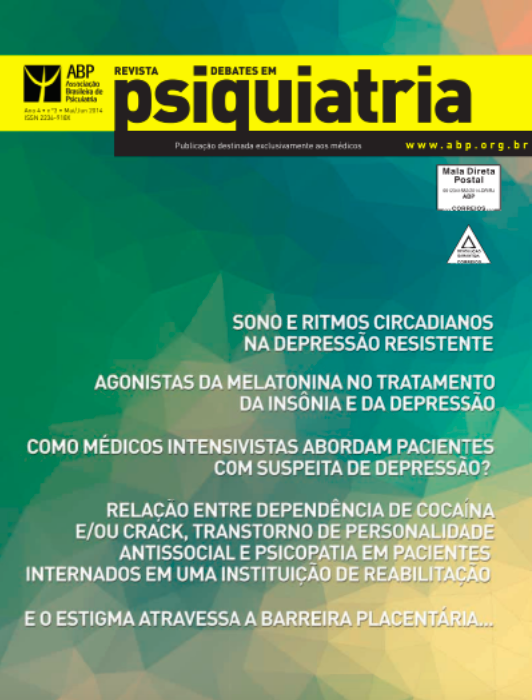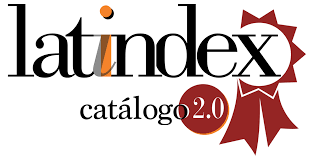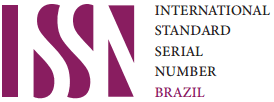Relation between cocaine and / or crack addction, antisocial personality disorder and psychopathy in patients admitted to a rehabilitation
DOI:
https://doi.org/10.25118/2236-918x-4-3-4Keywords:
Drug Addiction, Antisocial Personality Disorder, PsychopathyAbstract
Drug Addiction – DA – is a public and national health issue. In this context, a significant increase on cocaine and/or crack consumption is observed in the last few years. This study aimed to investigate the association between Cocaine and/or Crack Addiction, Antisocial Personality Disorder (ASPD) and psychopathy, and through its results, discuss possibilities and difficulties on the treatment of patients with such personality disorders and comorbidities. 30 Males in patients with a diagnose of drug addiction and ages raging from 19 to 53 years old (M= 30,30; SD= 8,44) took part in this survey. Study participants answered to the Drug
Abuse Screening Test ( DAST), the Mini International Neuropsychiatric Interview (M.I.N.I Plus) and the HARE PCL-R Scale. The results showed that the majority of cocaine and/or crack addicts were unemployed, single and carried a positive association with the psychopathy characteristics. Aside from these findings, it was also noted a high level of ASPD symptoms in this population. It is evident the need of DA treatments to address specific aspects of ASPD and psychopathy symptoms in order to obtain more effective results in the DA’s reduction and prevention.
Downloads
Metrics
References
-Diehl, A, Cordeiro, D, Laranjeira, R. Dependência Química: prevenção, tratamento e políticas públicas. (Artmed) 2011.
-Zanelatto, N, Laranjeira, R. O tratamento da dependência química e as terapias cognitivo-comportamentais. (Artmed) 2013.
-Scheffer, M, Passa, G. G, Almeida, R. M. M. Dependência de álcool, cocaína e crack e transtornos psiquiátricos. Psicologia: teoria e pesquisa. 2010; 26: 533 – 41.
-Mchug, R. Kathryn, H. B. A, Otto, M. W. Cognitive--behavioral therapy for substance use disorders. PsychiatricClinicsof North America. 2010; 33: 511–25. doi: 10.1016/j.psc.2010.04.012.
-Dualibi, L. B, Ribeiro, M, Laranjeira, R. Perfil de usuários de cocaína e crack no Brasil. Caderno de Saúde Pública. 2008; 24: 545-57.
-Kolling, N.M, Petry, M, Melo, W. V. Outras abordagens no tratamento da dependência do crack. Revista Brasileira de Terapias Cognitivas. 2011; 7: 7-14.
-Ribeiro, M, Laranjeira, R. O. Tratamento do Usuário de Crack.2ed2012.
-Ferreira, A. M. C. Gravidade de dependência química e motivação para o tratamento. O portal dos psicólogos. 2007: 1-31.
-ZaleskiI, M. Diretrizes da Associação Brasileira de Estudos do Álcool e outras Drogas (ABEAD) para o diagnóstico e tratamento de comorbidades psiquiátricas e dependência de álcool e outras substâncias. Revista Brasileira de Psiquiatria. 2006; 28:142-8.
-Alvez, H, Kessler, F, Ratto, L.R. C. Comorbidades: uso de álcool e outros transtornos psiquiátricos. Revista Brasileira de Psiquiatria.2004; 26: 51-3.
-Silva, C. J, Moura, D, Kolling, N, Castro Nunes, J, Mendes da Cunha, S, Kristensen, C. Comorbidade psiquiátrica em dependentes de cocaína/crack e alcoolistas: um estudo Exploratório. Aletheia.2009; 30: 101-12.
-Costa, J. B. P, Valerio, N. I. Transtorno de personalidade anti-social e transtornos por uso de substâncias: caracterização, comorbidades e desafios ao tratamento. Temas em Psicologia. 2008; 16: 119-32.
-Associação Psiquiátrica Americana .Manual Diagnóstico e Estatístico deTranstornos Mentais. 4. ed. Revista (DSM-IV-TR). 2002.
-ORGANIZAÇÃO MUNDIAL DE SAÚDE. Classificação dos transtornos mentais e do comportamento da CID-10: descrições clínicas e diretrizes diagnósticas.Trad. Caetano, D. 1993
- Davoglio, T.R, Argimon& Lima, I. I.. Avaliação de comportamentos anti-sociais e traços psicopatas em psicologia forense.Avaliação Psicológica.2010; 9: 111-8.
-Filho, N. H, Teixeira, M. A. P, Dias, A. C. G.. Psicopatia: o construto e sua avaliação. Avaliação psicologia. 2009; 8: 337-46.
-Henriques, R. P.. De H. Cleackley ao DSM-IV-TR: a evolução do conceito de psicopatia rumo àmedicalização da delinquência.Revista Latino-americana de Psicopatologia Fundamental. 2009; 12: 285-302.
- O`donohue, W, Fowler, K. A, Lilinfeld, S. O. Transtornos de Personalidade em Direção ao DSM-v. (Rocca) .2010.
- Cleckley, H. The Mask of Sanity. ( 5th ed.) St. Louis: Mosby. 1976.
- Alvarenga, M. A. S, Flores-Mendoza, C. E, Gontijo, D. F. Evolução do DSM quanto ao critério categorial de diagnóstico para o distúrbio da personalidade antissocial. Jornal Brasileiro de Psiquiatria. 2009; 58: 258-66
-Beck, A. T.; Freeman, Arthur & Davis Denise. Terapia Cognitiva dos Transtornos da Personalidade.(Artmed) 2005.
-Simon, R. Homens maus fazem o que homens bons sonham: Um psiquiatra forense ilumina o lado obscuro do comportamento humano;2009.
-Huss, M. T. Psicologia forense: pesquisa, prática clínica e aplicações;2011.
-Morana H, STONE, M. H, Abdalla Filho, E. Transtornode Personalidade, Psicopatia e Serial Killers. Revista Brasileira de Psiquiatria. 2006; 28: 74-9.
-Sousa, H. K. C,Hazboun, A, M, Rocha, Hannia R. R. P, Lucena, M.C. M. D. Transtorno antissocial de la personalidade: um estúdio teórico. Recuparado em 08 de 2012 de: http://www.neurologia.tv/bibliopsiquis/bitstream/10401/204/1/8conf950106.pdf
-Gibbon, S., Duggan, C., Stroffers, J, Huband, N., Vollm, B.,Ferriter, M, Lieb, KPsychological interventions for antisocial personality disorder. Cochrane DatabaseSystematicReviews, 2010;16 doi: 10.1002/14651858.CD007668. pub2.
-Hare, R. D. Sem consciência o mundo perturbador dos psicopatas que vivem entre nós. 2013. 240p.
-Skineer, H.A. Psychometric properties of the drug abuse screening test in the patient population. AddictiveBehaviors,1982, 7.
-Amorin, P. Mini International Neuropsychiatric Interview.1999.
-Morana, Hilda. Escala Hare PCL-R: critérios para pontuação de psicopatia revisados. Versão brasileira. 2004.
-Nunes, L. M. Sobre a Psicopatia e sua avaliação. Arquivos Brasileiros de Psicologia .2011; 63: 39-48.
-González, J. M. M. Substance dependence and personality disorder: relevant variables for their treatment. Papeles del Psicólogo.2011; 32: 166–174.
-Kessler, F. H. P.; Terra, M. B.; Falle, S.; Stolf, A. R.; Peuker, A. C.; Benzano, D. & Pechansky, F. Crack user show high rates of antisocial personality disorder, engagement in illegal activities and other psychosocial problems. The American Journal on Addiction. 2012; 2: 370-380. doi: 10.1111/j.1521-0391.2012.00245.x.
Downloads
Published
How to Cite
Issue
Section
License
Copyright (c) 2014 Jaluza Aimèe Schnei, Carolina Saraiva de Macedo Lisboa, Caroline Louise Mallmann

This work is licensed under a Creative Commons Attribution-NonCommercial 4.0 International License.
Debates em Psiquiatria allows the author (s) to keep their copyrights unrestricted. Allows the author (s) to retain their publication rights without restriction. Authors should ensure that the article is an original work without fabrication, fraud or plagiarism; does not infringe any copyright or right of ownership of any third party. Authors should also ensure that each one complies with the authorship requirements as recommended by the ICMJE and understand that if the article or part of it is flawed or fraudulent, each author shares responsibility.
Attribution-NonCommercial 4.0 International (CC BY-NC 4.0) - Debates em Psiquiatria is governed by the licencse CC-By-NC
You are free to:
- Share — copy and redistribute the material in any medium or format
- Adapt — remix, transform, and build upon the material
The licensor cannot revoke these freedoms as long as you follow the license terms. Under the following terms:
- Attribution — You must give appropriate credit, provide a link to the license, and indicate if changes were made. You may do so in any reasonable manner, but not in any way that suggests the licensor endorses you or your use.
- NonCommercial — You may not use the material for commercial purposes.
No additional restrictions — You may not apply legal terms or technological measures that legally restrict others from doing anything the license permits.






























